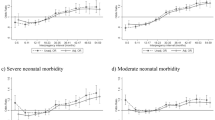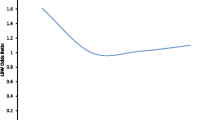Abstract
There is well-documented evidence on how interpregnancy interval (IPI) is associated with adverse perinatal outcomes and how short and long IPIs are associated with increased risk for preterm birth, low birth weight, and intra-uterine growth restriction. However, the extremes of IPI on infant mortality are less well documented. The current study builds on the existing evidence on IPI to examine if extremes of IPI are associated with infant mortality, and also examines if IPI is associated with both neonatal and post-neonatal mortality after adjusting for several known confounders. Matched birth and death certificate data for Arizona resident infants was drawn for 2003–2007 cohorts. The analysis was restricted to singleton births among resident mothers with a previous live birth (n = 1,466) and a randomly selected cohort of surviving infants during the same time-frame was used as a comparison group (n = 2,000). Logistic regression models were utilized to assess the odds for infant mortality at monthly interpregnancy intervals (<6, 6–11, 12–17, 18–23, 24–59, ≥60), while adjusting for established predictors of infant mortality (i.e., preterm birth, low birth weight, and small for gestational age), and other potential confounders. Unadjusted analysis showed greater clustering at extreme IPIs of <6 months and ≥60 months for infants that died (32 %) compared to infants that survived (24.7 %). Shorter IPI (i.e., <6 months, 6–11 months, and 12–17 months) compared to ‘ideal’ IPI (i.e., 18–23 months), were associated with infant mortality even after adjusting for confounders. Short intervals were significantly associated with neonatal, but not post-neonatal deaths. IPI above 23 months were not associated with infant mortality in our analyses. Shorter IPIs (18 months or less) significantly increases the risk for neonatal infant mortality even after controlling for known confounders, and our study adds to the existing evidence on adverse perinatal outcomes. Counseling women of reproductive age on the benefits of spacing pregnancies to at least 18 months addresses one preventable risk for early infant mortality.

Similar content being viewed by others
References
Arizona Department of Health Services. (2011). Health status monitoring reports. Available at: Accessed February 24, 2011.http://www.azdhs.gov/plan/index.htm.
IOM Committee on Understanding Premature Birth and Assuring Healthy Outcomes. (2006). Preterm birth causes, consequences and prevention, Available at: Accessed March 3, 2011.http://www.iom.edu/Reports/2006/Preterm-Birth-Causes-Consequences-and-Prevention.aspx.
Martin, J. A., Hamilton, B. E., Sutton, P. D., et al. (2009). Births: Final data for 2006. National Center for Health Statistics, 57(7), 1–102.
World Health Organization. (2006). Report of a WHO technical consultation on birth spacing. Accessed March 4, 2011. Available at: http://www.who.int/making_pregnancy_safer/documents/birth_spacing.pdf.
Conde-Agudelo, A., Rosas-Bermu′dez, A., & Kafury-Goeta, A. C. (2006). Birth spacing and risk of adverse perinatal outcomes: A meta-analysis. Journal of the American Medical Association, 295(15), 1809–1823.
Conde-Agudelo, A., Rosas-Bermudez, A., & Kafury-Goeta, A. C. (2007). Effects of birth spacing on maternal health: A systematic review. American Journal of Obstetrics Gynecology, 196(4), 297–308.
Hsieh, T. T., Chen, S. F., Shau, W. Y., Hsieh, C. C., Hsu, J. J., & Hung, T. H. (2005). The impact of interpregnancy interval and previous preterm birth on the subsequent risk of preterm birth. Journal of the Society for Gynecologic Investigation, 12(3), 202–207.
Huttly, S. R., Victora, C. G., Barros, F. C., & Vaughan, J. P. (1992). Birth spacing and child health in urban Brazilian children. Pediatrics, 89(6 Pt 1), 1049–1054.
Khoshnood, B., Lee, K. S., Wall, S., Hsieh, H. L., & Mittendorf, R. (1998). Short interpregnancy intervals and the risk of adverse birth outcomes among five racial/ethnic groups in the United States. American Journal of Epidemiology, 148(8), 798–805.
Smith, G. C., Pell, J. P., & Dobbie, R. (2003). Interpregnancy interval and risk of preterm birth and neonatal death: Retrospective cohort study. British Medical Journal, 327(7410), 1–6.
Grisaru-Granovsky, S., Gordon, E. S., Haklai, Z., Samueloff, A., & Schimmel, M. M. (2009). Effect of interpregnancy interval on adverse perinatal outcomes—a national study. Contraception, 80(6), 512–518.
Zhu, B. P., Rolfs, R. T., Nangle, B. E., & Horan, J. M. (1999). Effect of the interval between pregnancies on perinatal outcomes. New England Journal of Medicine, 340(8), 589–594.
Ekwo, E. E., & Moawad, A. (1998). The relationship of interpregnancy interval to the risk of preterm births to black and white women. International Journal of Epidemiology, 27(1), 68–73.
Zhu, B. P. (2005). Effect of interpregnancy interval on birth outcomes: Findings from three recent US studies. International Journal of Gynecology and Obstetrics, 89(Suppl. 1), S25–S33.
Winkvist, A., Rasmussen, K. M., & Habicht, J. P. (1992). A new definition of maternal depletion syndrome. American Journal of Public Health, 82(5), 691–694.
Smits, L. J. M., & Essed, G. G. M. (2001). Short interpregnancy intervals and unfavourable pregnancy outcome: Role of folate depletion. The Lancet, 358(9298), 2074–2077.
Stephansson, O., Dickman, P. W., & Cnattingius, S. (2003). The influence of interpregnancy interval on the subsequent risk of stillbirth and early neonatal death. The American College of Obstetricians and Gynecologists, 102(1), 101–108.
Weger, F. J., Hukkelhoven, C. W. P. M., Serroyen, J., Velde, E. R., & Smits, L. J. M. (2011). Advanced maternal age, short interpregnancy interval, and perinatal outcome. American Journal of Obstetrics and Gynecology, 204(5), 421e1–421e9.
Erickson, J. D., & Bjerkedal, T. (1979). Interval between pregnancies. The Lancet, 313(8106), 52.
Klebanoff, M. A. (1999). The interval between pregnancies and the outcome of subsequent births. New England Journal of Medicine, 340(8), 643–644.
Rutstein, S. O. (2005). Effects of preceding birth intervals on neonatal, infant and under-five years mortality and nutritional status in developing countries: Evidence from the demographic and health surveys. International Journal of Gynecology and Obstetrics, 89, S7–S24.
Mathews, T. J., & MacDorman, M. F. (2008). Infant mortality statistics from the 2005 period linked birth/infant death data set. National Center for Health Statistics, 57(2), 1–32.
Schempf, A. H., Branum, A. M., Lukacs, D. O., & Schoendorf, K. C. (2007). The Contribution of preterm birth to the black-white infant mortality gap, 1990 and 2000. American Journal of Public Health, 97(7), 1255–1260.
Callaghan, W. M., MacDorman, M. F., Rasmussen, S. A., Qin, C., & Lackritz, E. M. (2006). The contribution of preterm birth to infant mortality rates in the United States. Pediatrics, 118(4), 1566–1573.
Kramer, M. S., Platt, R. W., Wen, S. W., Joseph, K. S., Allen, A., Abrahamowicz, M., et al. (2001). A new and improved population-based Canadian reference for birth weight for gestational age. Pediatrics, 108(2), 1–7.
The centers for disease control and prevention. Tobacco use and pregnancy. Available at: Accessed February 9, 2011.http://www.cdc.gov/reproductivehealth/tobaccousepregnancy/.
National Center for Health Statistics. (2000). Report of the panel to evaluate the U.S. standard certificates. Available at Accessed March 5, 2011.http://www.cdc.gov/nchs/nvss/vital_certificate_revisions.htm.
Cooper, L. G., Leland, N. L., & Alexander, G. (1995). Effect of maternal age on birth outcomes among young adolescents. Social Biology, 42(1–2), 22–35.
Jacobsson, B., Ladfors, L., & Milsom, I. (2004). Advanced maternal age and adverse perinatal outcome. Obstetrics and Gynecology, 104(4), 727–733.
Taylor, C. R., Alexander, R. S., & Hepworth, J. T. (2005). Clustering of U.S. women receiving no prenatal care: Differences in pregnancy outcomes and implications for targeting interventions. Maternal and Child Health Journal, 9(2), 125–133.
Bryant-Borders, A. E., Grobman, W. A., Amsden, L. B., & Holl, J. L. (2007). Chronic stress and low birth weight neonates in a low-income population of women. Obstetrics and Gynecology, 109(2), 331–338.
Bloch, J. R., Webb, D. A., Mathews, L., Dennis, E. F., Bennett, I. M., & Culhane, J. F. (2009). Beyond marital status: The quality of the mother-father relationship and its influence on reproductive health behaviors and outcomes among unmarried low income pregnant women. Maternal and Child Health Journal, 14(5), 726–734.
Arizona Department of Health Services. (2010). Arizona health status and vital statistics. Available at: Accessed March 5, 2011.http://www.azdhs.gov/plan/index.htm.
Lynn, H. (2003). Suppression and confounding in action. The American Statistician, 57(1), 58–61.
Rosenberg, T. J., Garbers, S., Lipkind, H., & Chiasson, M. A. (2005). Maternal obesity and diabetes as risk factors for adverse pregnancy outcomes: differences among 4 racial/ethnic groups. American Journal of Public Health, 95(9), 1545–1551.
Smith, G. C. S., Shah, I., Pell, J. P., Crossley, J. A., & Dobbie, R. (2007). Maternal obesity in early pregnancy and risk of spontaneous and elective preterm deliveries: A retrospective cohort study. American Journal of Public Health, 95(9), 1545–1551.
USAID Family Planning. (2011). Birth spacing. Available at: Accessed April 12, 2011. http://www.usaid.gov/our_work/global_health/pop/techareas/birthspacing/index.html.
Broussard, D. L., Sappenfield, W. B., Fussman, C., Kroelinger, C. D., & Grigorescu, V. (2010). Core state preconception health indicators: A voluntary. Multi-state Selection Process. Maternal and Child Health Journal. doi:10.1007/s10995-010-0575-x.
Author information
Authors and Affiliations
Corresponding author
Rights and permissions
About this article
Cite this article
Hussaini, K.S., Ritenour, D. & Coonrod, D.V. Interpregnancy Intervals and the Risk for Infant Mortality: A Case Control Study of Arizona Infants 2003–2007. Matern Child Health J 17, 646–653 (2013). https://doi.org/10.1007/s10995-012-1041-8
Published:
Issue Date:
DOI: https://doi.org/10.1007/s10995-012-1041-8




